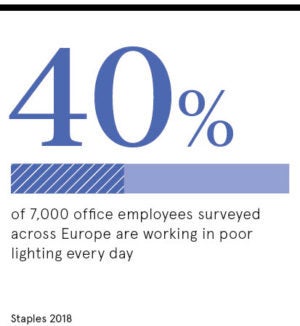With an increased awareness of how our surroundings can impact health and productivity, and its potential to cut healthcare costs and help businesses flourish, companies are focusing their attention on how to use architecture for mental health and wellbeing.
Buildings designed to make us happier and healthier, however, can be costly. And while technology unicorns and high-net-worth individuals have the firepower to spend millions on creating wellbeing-centric havens, can creative mental health and design ever be implemented for the masses?
Workplaces focussed on wellbeing
Offices have constantly evolved to meet and pre-empt changes in how we work, and there is now a huge incentive for companies to invest in architecture for mental health and wellbeing, including alleviating turnover and recruitment costs.
This means encouraging choice, movement and relaxation, controlling temperature, noise levels and air quality, and adding breakout areas, ergonomic furniture, plants and even nap pods where workers can rest during their lunch break.
David Watts, managing director of CCD Design & Ergonomics, says companies are also increasingly understanding the variety of employees’ personality types, such as introverts and extroverts.
“More organisations are questioning whether open plan encourages collaboration, as everyone thought. Open plan is better suited to extroverts, while different design solutions are needed for introverts,” he says.
The industry is notoriously conservative, so innovation tends to come from the affordable sector or by government regulation
But large-scale office refurbishments need not be the only solution and low-cost solutions can be easily implemented.
“The principles are achievable for lots of different organisations; put art up, allow staff input over their own environment,” says Mr Watts.
Another affordable option is to use nudge theory to encourage people to make healthier choices, such as providing healthier food for staff and making water easily available, says Ann Marie Aguilar, International Well Building Institute’s director of operations for Europe, whose organisation’s WELL standard launched in 2014 and operates in 55 countries.
WELL incorporates concepts to help improve the health of people working inside buildings, including air, water, nourishment, light, movement, comfort, materials and sound. Projects are showing reduced absenteeism and increased happiness and productivity after 12 months. Air quality is the most important concept, says Ms Aguilar.
“Indoor spaces can be five to ten times worse than outside, so materials are really important. This allows us to put pressure on architects to ensure they’re only specifying materials that don’t bring volatile organic compounds, associated with new furniture and laminates, into internal environments, where people breathe it in.”
Design at home crucial for mental health
 Housing is another huge opportunity for wellbeing, mental health and design. WELL is shifting its focus to architecture for mental health and wellbeing in social and affordable housing, but it’s not an easy task.
Housing is another huge opportunity for wellbeing, mental health and design. WELL is shifting its focus to architecture for mental health and wellbeing in social and affordable housing, but it’s not an easy task.
“It’s challenging for us to get to someone who’s willing to trial a new approach; everyone defers back to way before. We just need one brave housing association to put their head above the parapet and try something new,” she says.
But standards for affordable social housing have been steadily eroding since their emergence in the 19th century, argues Richard Turkington, director at Housing Vision.
“It’s all about standards set by the state with adequate resources to build homes though subsidy, and powers to monitor and take action if required,” he says.
“Our research shows that rent is often not the primary source of stress,” say Steve Rolf, research fellow at the University of Stirling. “It’s the unpredictable costs associated with moving, furnishing and redecorating.
“For tenants moving into properties that need a lot of work, this can mean getting into debt or living in a property that doesn’t feel like home, which can negatively affect health and wellbeing.
“Although it costs more to provide tenants with properties of a good standard of design, they’re more likely to stay longer in better quality properties, which reduces turnover costs.”
Mr Turkington says cost is the biggest challenge for the construction industry. “For housing to be affordable, it needs to be subsidised, either as a direct grant from the government to reduce build cost, or direct or indirect cross-subsidies,” he says.
This could be, for example, the profit on market-value schemes where a housing estate is redeveloped or some new market housing is used to support affordable housing.
Investing in architecture for mental health
The construction industry can take steps to bring costs down and to get more for the same money, adds Mr Turkington.
“The main innovations with materials are greater use of wood, concrete and composites, and achieving a high level of thermal efficiency through double or triple-glazing solar energy.”
While prefabrication of houses is a good example of this, Mr Turkington says there needs to be more innovation.
“The construction industry is notoriously conservative, so innovation has tended to come from the affordable sector or by government regulation,” he says.
Mr Watts agrees that a major obstacle for the construction industry is designing and building for flexibility and change.
“The infrastructure of our homes and workplaces aren’t easy to change; some of these issues are demanding that it becomes easier to adapt them,” he says.
While it may seem more challenging to invest in architecture for mental health and wellbeing with affordable housing, it can have huge returns on investment.
“By building to better standards now, we’re avoiding constructing slums. Better housing that lasts longer is better for everyone’s health, allows people to stay in stable communities and saves money for the public purse,” says architect Sarah Wigglesworth.
“If we want to make the greatest difference to future NHS budgets, it’s social housing we should be concentrating on.”
Workplaces focussed on wellbeing
Design at home crucial for mental health

